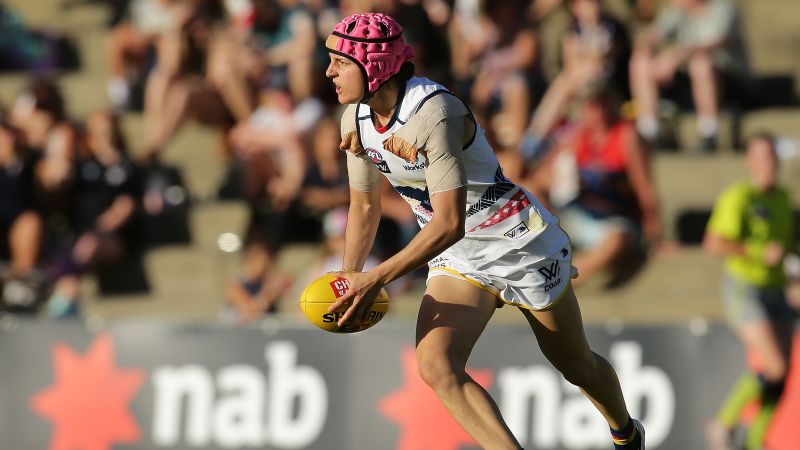Brisbane, Australia
CNN
—
Scientists in Australia have diagnosed the world’s first case of chronic traumatic encephalopathy, or CTE, in a professional female athlete, with implications for millions of girls and women who play contact sport.
Heather Anderson, an Australian Football League (AFL) player, was found to have low-stage CTE during an autopsy by scientists at the Australian Sports Brain Bank, whose peer-reviewed findings were published last week in the medical journal Acta Neuropathologica.
CTE is a neurodegenerative disease that can occur after repeated traumatic brain injuries or hits to the head, with or without a concussion, and to date it has only been diagnosed in professional male athletes.
But the rise of women’s participation in the same sports over the past two decades means they too are susceptible, the paper said, and especially so given research indicates that women are more vulnerable to concussion than men.
“Colleagues overseas been watching the professionalization of women’s contact sports over the last 10 years, and the surge in popularity and surge in participation by women in contact sports, so we’ve all been sort of thinking sooner or later, this disease is going to pop up,” said neuropathologist Michael Buckland, the paper’s co-author.
“It’s a bit like smoking and lung cancer. Early on lung cancer was enormous in men … and then women took up smoking in equal numbers. Then 20 years later, there was a big surge in women’s lung cancer,” said Buckland, a clinical associate professor at the University of Sydney.
“So I think we’re at the start of seeing the consequences of that surge in participation, both at the amateur and professional level.”
Anderson started playing football when she was five years old and went on to play contact sport for 18 years across two codes – AFL and rugby league – before her death by suicide at 28 last November, according to the paper.
Her professional career included 8 games over the 2017 season with AFL Club the Adelaide Crows, before she suffered a shoulder injury that ended her sporting career. She also worked as a medic for the Australian Defence Force.
Originally from Darwin, Anderson was known for wearing a bright pink helmet on the pitch so her vision-impaired mother could see her play. Scientists say helmets and headbands can prevent skull fractures but don’t keep the brain from moving around inside the skull when someone is hit.
During her career, Anderson had one confirmed concussion, and suffered another suspected four, according to her family, who donated her brain to the Australian Sports Brain Bank for more answers as to why she died.
According to the paper, Anderson had no known history of alcohol or non-prescription drug abuse and had not exhibited any signs of depression or unusual behavior in the months before her death.
“While there are insufficient data to draw conclusions on any association between CTE and manner of death, suicide deaths are not uncommon in the cohorts where CTE is sought at autopsy,” the paper said.
Buckland said Anderson’s diagnosis shows women’s contact sports also need CTE minimization plans to reduce players’ exposure to cumulative head injuries, and those plans need to start at the junior level.
“I don’t think any child should be playing the contact version of a sport before high school,” he said. Other ways to reduce exposure include restricting contact during training, playing just one contact sport, and taking time off after a game when players have suffered hits, he said.
Awareness of the risks of head injury in sport has been growing over the past two decades, and scientists are still working to examine the impact of repeated knocks on the brain.
The US Centers for Disease Control and Prevention says “the research to date suggests that CTE is caused in part by repeated traumatic brain injuries, including concussions, and repeated hits to the head, called subconcussive head impacts.”
Repeated knocks can lead to the degeneration of brain tissue and an unusual buildup of a protein called tau, which is associated with symptoms such as memory loss, confusion, impulse control problems, aggression, depression, impaired judgment and suicidal behavior.
In the United States, the most recent research from the Concussion Legacy Foundation and Boston University’s CTE Center found that nearly 92% of 376 former NFL players who were studied were diagnosed with the brain disease. It’s also been found in the brains of former boxers, and ice hockey and soccer players.
In Australia, lawyers representing dozens of former professional AFL players have filed a class action suit against the Australian Football League (AFL), seeking compensation for injuries caused by alleged negligence.
The AFL has acknowledged a link between head trauma and CTE and says it’s committed to mitigating the risks. It was one of dozens of parties to provide submissions to an Australian government inquiry into the issue that is due to report on August 2.
The AFL Player’s Association, which represents the athletes, is pushing for greater support for current and former players, many of whom are living with the impact of successive brain injuries.
But Buckland said with so many other competing priorities, including broadcast rights and ticket sales, the industry can’t be expected to self-regulate, and an outside body needs to set the rules to ensure they’re followed.
CTE has been diagnosed in people as young as 17, but symptoms usually don’t appear until years later.
In 2019, about 15% of all US high school students reported one or more sports- or recreation-related concussions in the previous year, according to the US Centers for Disease Control and Prevention. Boys’ football, girls’ soccer and boys’ ice hockey were the sports with the highest concussion rates, according to the study.
Buckland said what’s most needed is a shift in attitudes, so that it’s no longer encouraged or even acceptable to expose children to activities where repeated head injuries are part of the game.
“It’s more than just a medical problem, it’s a sociological problem, as well. How do we change society? I think in the long run, it’ll be like smoking. (Stopping) smoking has taken generational change, and I think that’s what we’re looking at here.”
Sumber: www.cnn.com





